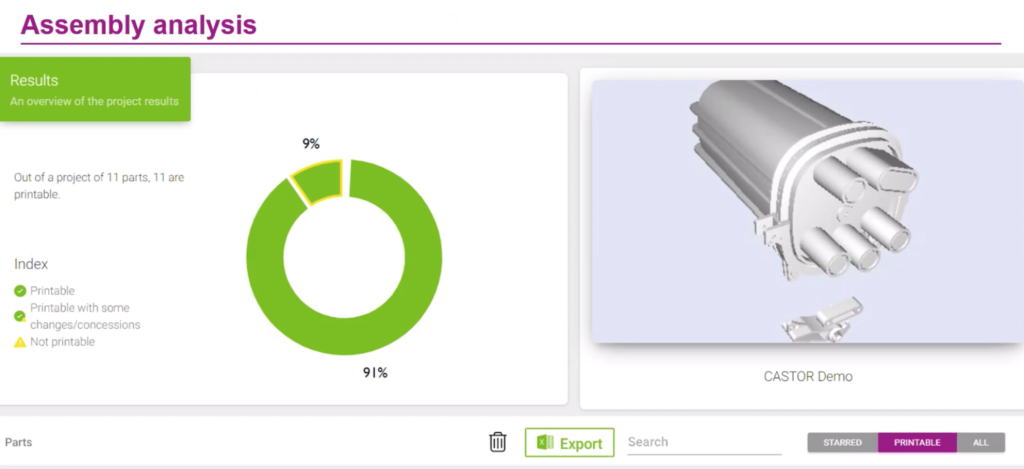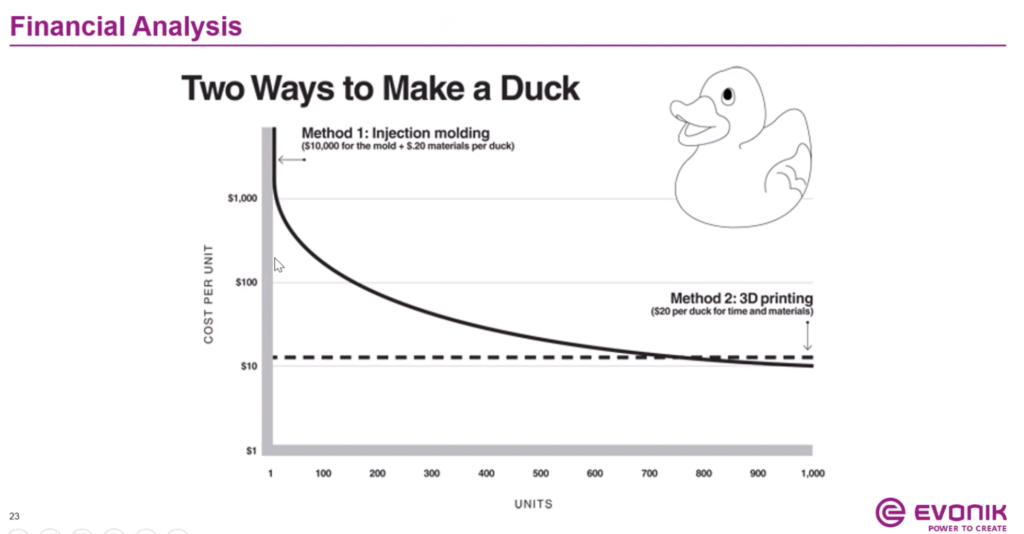Just over a week ago, specialty chemicals and 3D printing materials company Evonik announced the introduction of a new software tool for additive manufacturing (AM). Developed by Castor, an Israeli startup in which Evonik’s Venture Capital invested in late 2019, their new 3D screener offers a software technology that assesses a part’s printability, recommends the best printing material, and estimates its cost and lead time. Recently Evonik teamed up with Castor for a webinar to introduce their new software tool.
During the 30 minute experience, Sylvia Monsheimer, head of the market segment for new 3D printing technologies at Evonik, and Omer Blaier, co-founder and CEO of Castor, presented each of their companies as well as the newly created technology that helps manufacturers decide if and how they should apply 3D printing to their production processes.
The duo suggested that Evonik’s 3D screener has three main features. Blaier indicated that on the “technical side we can find the geometry which will focus on wall thickness; while on the materials side of the software, the focus is especially on the mechanical properties that are needed to be taken into consideration when comparing materials to the original materials they were made of. And finally, the financials of the break-even point for AM as compared to traditional manufacturing processes.”
“Castor is a complete decision support system for utilizing industrial 3D printing. Which means that we allow manufacturers to decide whether to use their 3D printing over traditional manufacturing methods, figuring out where it can save them time and money,” explained Blaier. “We offer technical analysis and cost saving advice, to determine whether it makes sense to use 3D printing or not. The algorithm provides a report on each one of the end-use parts design being analyzed and whether it makes sense to use AM or not, what is the best technology and material for the part.”
Castor’s already established decision support system for utilizing industrial 3D printing, combines intelligence with 3D printing accessibility for manufacturers, avoiding costly spending on limited quantity batches and reducing lead time.
Evonik has contributed its expertise in 3D printing materials and helped Castor establish the software as a platform accessible for all industries. With Evonik’s software based on Castor technology, customers now have the opportunity to identify parts that could be printed with materials such as high-performance polymer powders and filaments. Evonik also produces a full range of additives that can modify material properties, for example, improving the flowability or making the finished part more robust.
According to Monsheimer and Blaier, in just one week, 20 companies have already registered on their 3D Screener site to try out the software.
Well into the webinar, they presented a few examples of the software at work. One of the first screens of the report is an analysis of an assembly that one of their users had already uploaded, which in this case basically means that a manufacturer hopes to explore whether a whole product can be produced with Evonik’s materials or not. In the assembly analysis report, there is an overview of the project results, with the program determining what parts are printable, what parts are printable with some changes and what parts cannot be printed. This type of analysis to determine 3D printability for end-use parts designs is what Blaier considers “an interest point of the report.”
“We have a few elements that help engineers with the analysis, to understand what the gap is between the design and the limitations of 3D printing as they relate to Evonik’s materials,” said Blaier.
On the next slide, audiences were able to observe how generating a heat map of a part leads to a wall thickness analysis, which in this case is for an unprintable part as can be seen from a few red areas of the part. Blaier indicates that “it is a tool that gives a hint of a redesign for additive manufacturing, in case the geometry doesn’t fit.”
A leader in polymers since 1955, Evonik serves all major polymer-based 3D printing technologies. Monsheimer described in detail each one of the materials offered by the company for use in AM, from Powder Bed Fusion to FDM and SLA. The expert described “the development of new and improved polymer system solutions for Additive Manufacturing using synergies with powder and liquid polymers as part of the exploration of next-generation polymer solutions using improved materials so that we can think of the business of tomorrow.”
According to Blaier, the final slide from the 3D screener “describes the best match material out of Evonik’s materials, that matches the original material that the engineer chose when designing the part for traditional manufacturing methods. This was done based on the user preference for different mechanical properties,” he said.
“You can actually configure the preference of the user for different mechanical properties, so if, for example, I am sensitive to costs, strengths or heat resistance, the results in Evonik materials will be different. And here you can see the comparison between the two materials.”
“The software also gives a quick analysis of the economics behind 3D printing versus injection molding. Indicating the break-even point of quantities, so that, for instance, a cost of $12 per unit for 800 parts is just right for 3D printing, however, if the demand is for more than 800 parts, customers should consider using injection molding,” resumed Blaier.
Castor automatically runs an analysis to determine 3D printability for end-use parts design, chooses the suitable technology for printing while maintaining functionality, and turns multiple parts into one to maximize manufacturing possibilities for unique designs.
“When we look at Additive Manufacturing we understand what happens inside the machine, so, for me, this [the 3D screener] is a part where we can fill a gap for our customers, which, in turn, helps them close gaps in the production chain,” indicated Monsheimer. “We like to think from the perspective of our customers, that is, one of the motivations of Additive Manufacturing at the end of the day is to save money. If it is much too expensive to produce with injection molding, they should have better opportunities, freedom of design, integration of design with parts that can only be manufactured using 3D printing technologies, and integration of several parts into one which make for a better production process.”
Blaier highlighted that for Castor, this is a win-win situation since “we allow Evonik to reach out to end-users, customers, and we are enjoying the expertise of Evonik on polymers to improve our expertise in software.”
Finally, Blaier asserted that Evonik’s 3D screener tool is a cloud-based solution in Germany running through certification of Evonik’s IT department that encrypts the parts when they are uploading to the cloud.
Determining the most suitable 3D printing material and the right method for the production process can change the end results for manufacturers, and knowing when to use 3D printing is fundamental to keep up with a modernized business. According to the two specialists, Evonik’s new software could make a difference in how customers begin to tackle a problem that has led to high costs and lead times. With more and more companies turning to software-based solutions from established companies, we can only expect that the industry will run even smoother in the next decade.
Subscribe to Our Email Newsletter
Stay up-to-date on all the latest news from the 3D printing industry and receive information and offers from third party vendors.
Print Services
Upload your 3D Models and get them printed quickly and efficiently.
You May Also Like
Johns Hopkins University Researchers Develop HyFAM Technology
Two scientists from Johns Hopkins University, Nathan C. Brown and Jochen Mueller, have developed a hybrid manufacturing technology they call HyFam, or Hybrid Formative Additive Manufacturing. Their work on this technology...
3D Printing G-Code Gets an Upgrade: T-Code
Good old G-Code still manages many 3D printers, great and small. Just like the STL, it’s a standard that enables collaboration while also holding the additive manufacturing (AM) industry back....
AM Rewind: The Biggest News and Trends of 2024
After a sluggish 2023, driven by persistent inflation and geopolitical tensions, 2024 has seen some recovery. Economic growth climbed from about 2.8 percent in 2023 to a modest 3.2 percent...
Metal Wire 3D Printer OEM ValCUN Announces Plans for 2025 Expansion
ValCUN, a Belgian original equipment manufacturer (OEM) of wire-based metal additive manufacturing (AM) hardware, has announced that the company has entered the next phase of its growth trajectory, making key...






































